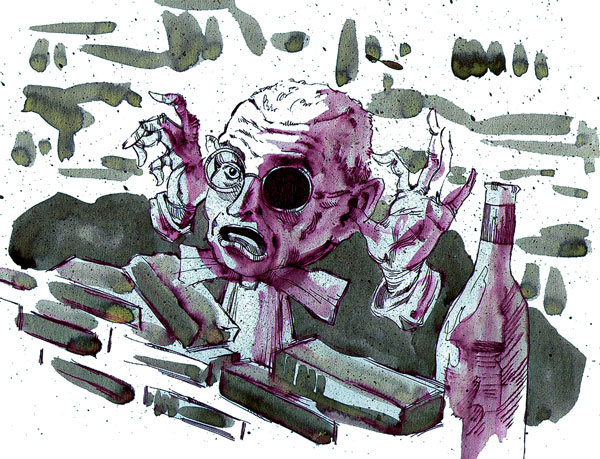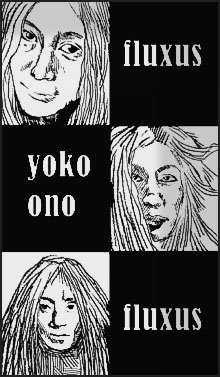
Fluxus is an international art movement of the 60s and 70s of the XX century, whose followers combined diverse forms of artistic expression and means of communication in their works. The main idea of Fluxus is the spontaneous creative process expressed in the form of a performance, installation, action, or show, which carries minimal significance for both the artist and the audience.
Fluxus often includes not only visual art elements but also components of music, poetry, choreography, and acting. Members of this movement consciously rejected any limitations of creativity, while their philosophy has much in common with the popular avant-garde movement of the early XXth century – Dadaism.
Distinguishing Features of Fluxus
According to most of its followers, Fluxus is the exact opposite of both academic and commercial art. Many artists’ works were created in a satirical and even tough manner, thereby trying to erase the boundaries between ordinary people’s lives and high art.
The main characteristics of Fluxus include:
- Globalism. Members of this movement do not recognize borders among different countries’ cultures but advocate free access to art for anyone, regardless of their social status, origin, or nationality.
- Extensive use of intermedia. However, the use of a particular media technology should be meaningful without any commercial components.
- Randomness. Any artist’s action should be unpredictable, and intentional intervention to achieve a predetermined effect is not allowed.
- Game. The creative process should be fun, involving not only the artists but also the audience.
- Simplicity. The author expresses ideas in the simplest possible way by using the most trivial things that can always be found unusual.
- The experimental nature of creativity. There can be no mistakes or failures, and each work has the right to life.
- Musicality. Moreover, the true artist can create musical stuff out of the most unusual things that most people absolutely do not associate with music.

Fluxus stands out from other modern movements in the great diversity of its followers, including artists, poets, composers, writers, musicians, and philosophers. Furthermore, this revolutionary movement gave the world a unique type of artwork – scores. The idea of a score is that the artist describes a sequence of actions in detail, which can be done by anyone who wants to join the art world.
History of Fluxus Development
The history of Fluxus dates back to the late 1950s when the young artist George Maciunas first heard the theory about the simplicity of art and the beauty of everyday things at a lecture by the famous composer John Cage. At the same time, Allan Kaprow developed the concept of “happening” and introduced it to the general public, and Ray Johnson invented “mail-art.”
That is when Maciunas came up with the idea of creating a new movement of contemporary art, which, according to his plan, should have combined the ideas of the Dadaists, abstract expressionists, the Chinese doctrine of Zen, and the founders of the German Bauhaus school.
With his energetic nature and powerful charisma, Maciunas began assembling a group of like-minded people and working out a coherent concept of the movement. First, he decided to call his revolutionary movement a “new Dadaism” and even wrote a letter outlining his ideas to Raoul Hausmann, one of the most famous Dadaists at that time. But the recognized master of avant-garde art suggested changing the name to “Fluxus” so as not to confuse the public.

In 1962, Maciunas and a group of members organized a series of Fluxfest festivals in several Western European countries, presenting original works by members of the movement. The primary purpose of these events was to raise funds for Fluxus magazine, where the artists intended to publish their works.
However, in reality, events developed quite differently, and the magazine’s publication was delayed for several years. But with the help of festivals, a new movement has gained many followers in different parts of the world. Joseph Beuys – one of the founders of this movement, suggested to Maciunas writing a manifesto stating the main ideas of Fluxus, which was characterized by extreme radicalism.
The manifesto was first presented at the “Fluxorum” festival in Düsseldorf in 1963. Its ideas led to a split in the new movement. Some of its members, led by Karlheinz Stockhausen, refused to take part in radical actions against museums and theaters, for which they were immediately excluded from the Fluxus.
Nevertheless, Maciunas subsequently continued to cooperate closely with the excluded members of the movement. At the same time, he began to form a network of regional branches of the movement all over the world, trying to create a manageable homogeneous structure under his leadership. But among innovative artists, it was complicated to implement the idea of a centralized movement with strict discipline, although Maciunas never abandoned it. As a result, many regional branches eventually removed the word “Fluxus” from the name of their associations. However, this did not stop them from taking part in festivals and interacting with other artists.
For almost 20 years, Maciunas remained the main driving force of the movement, attracting many new members every year with his drive and determination and trying to coordinate the various branches. But in 1978, the founder of the movement died of cancer, and the movement finally lost any signs of control. After that, public and critical interest in Fluxus decreased markedly during the next 20 years, only to flare up with renewed vigor at the beginning of the XXI century.

The Most Famous Followers of Fluxus
There are many iconic figures in modern art history among the movement’s proponents, but still, the most famous followers of Fluxus are:
- George Maciunas – American artist and composer of Lithuanian origin, the unqualified leader of the movement for 20 years. Maciunas got along well with people and literally inspired them with his non-trivial ideas.
- George Brecht was the inventor of the famous event scores, a chemist by training, and an artist and a musician by vocation. Brecht was also a fan of Zen Buddhism and even translated the ancient philosophical poem “Xinxin Ming” from Chinese.
- Joseph Beuys was a German artist, a creative orator, and author of numerous performances. In his works, Beuys often touched upon the alienation of modern people from living nature.
- Yoko Ono is a Japanese avant-garde artist and singer, the widow of John Lennon, the author of many spectacular performances.
The ideas of Fluxus proved to be very viable, and the philosophy of the movement continues to live on: at festivals, exhibitions, and forums of contemporary art. In the XXI century, in different corners of the world, the Fluxus museums began to open. On the Internet, many websites are devoted to the history of the appearance, development, and promotion of this unusual movement of modern art.





